How to "ID" 70-72 Buick & 71-72 Oldsmobile
A-Body Sport Mirrors
by Duane Heckman
Sport Mirrors are one of the most popular options guys like
to add when redoing their vehicles. They not only look nice, but with good
examples of standard chrome mirrors getting more expensive and harder to
find, they are gaining popularity.
You can find Sport Mirrors for sale all over the place, however
the main problem is making sure you buy the correct ones. These mirrors
were optional on almost every GM body style from the early 70's thru to
at least the 90's, and the differences between many of them are not readily
apparent. Right mirror image is a little grainy.
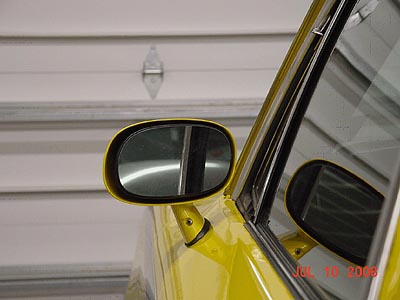
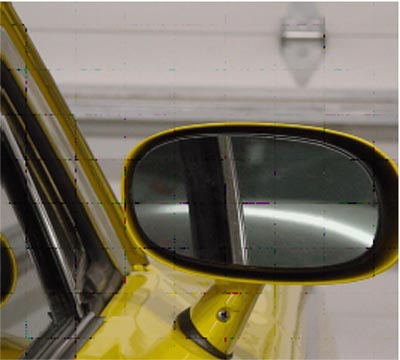 One of the reasons for the mirror differences had to do with
the outer door skins. When installed properly the tops of the mirrors are
parallel to the ground. (See the above pictures.) To accomplish this GM
needed to take into account the differences in door skin angles for the
various models. They did this in one of two ways:
One of the reasons for the mirror differences had to do with
the outer door skins. When installed properly the tops of the mirrors are
parallel to the ground. (See the above pictures.) To accomplish this GM
needed to take into account the differences in door skin angles for the
various models. They did this in one of two ways:
1. They left the mirror housings the same, and changed only the mounting gaskets or
2. They changed the bottom housing that mounts to the door skins.
Then, to further add to the number of variables, as new models
were introduced GM often changed the mirror designs. Normally this would
not create an identification problem, but many of these changes were so
slight that unless you have the mirrors next to each other you cannot see
the differences.
The result is that people have trouble telling the mirrors
apart, and are constantly selling mirrors for the wrong applications. Often
this "mistake" is not discovered until the mirrors are repainted
and installed on the car. Then the owner notices the tops of the mirrors
are "cocked" inwards towards the center of the car, and they look
stupid. At this point I usually get a phone call from the "Buick guys",
as I am the guy that sells the "Buick style" mirror gaskets, and
often have to explain that they purchased the wrong mirrors and need to
keep looking for the right ones. (This is definitely not the way to make
friends.)
The above scenario is becoming so common that I decided it
was time to write this article to help everyone avoid this problem. To do
this I took information from mirrors that were known to be correct and started
looking at the piles of "parts" mirrors that I had in my inventory.
While doing this I found at least 3 different mirrors (different casting
numbers) that could easily be mistaken for the correct early mirrors and
discovered that GM had also changed the mirror glass assemblies slightly.
I even tried to install these "later" mirror glass assemblies
into the earlier housings and discovered they were larger and would not
fit correctly. Therefore, for identification purposes, I will also include
the glass date code information to help ID the correct assemblies.
Identifying the Correct Mirrors
The first thing to note is the Sport Mirrors for both 70-72
Buick & 71-72 Oldsmobile A-bodies are identical in every way, with the
exception of the mounting gaskets. The Buicks use a wedge shaped gasket
(pictured above) while the Olds use a flat one with a thin raised lip at
the outer edge. This allows the Olds mirrors to mount "flush"
to the door skins, while the Buick mirrors require a beveled gasket to "shim"
the mirrors so they sit correctly.
Another thing to note are the numbers that are cast into
the housings. These casting numbers identify each piece of the assembly.
On the upper housings the numbers are located behind the mirror, so if you
tilt the mirror to one side both the number and date code can be seen easily.
The numbers on the bases are located on the top of the part, where they
attach to the upper housing. To check these numbers you need to take the
mirrors apart to view them. Also, the numbers on the right hand bases are
extremely hard to read (Cast very lightly); therefore it might be necessary
to look at both the left and right bases before determining if they are
correct.
The upper housings also have a variety of "Date Code
Clock" cast into them. These codes have the last digit of the production
year placed within a circle, with 12 spokes radiating out from it. Each
spoke designates a month, with the longest spoke being January. Often a
series of raised dots are used to indicate the month of manufacture, although
in this case a single dot is used. Regardless of the number of dots, the
last month with a raised dot will be the month of manufacture. In our case
(See below pictures) the dot is placed at the end of the 4th spoke, therefore
the casting dates for both these housings are April of 1972.
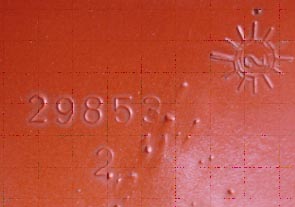
 Here are pictures of the left & right upper mirror housing
casting numbers and date code clocks.
Here are pictures of the left & right upper mirror housing
casting numbers and date code clocks.
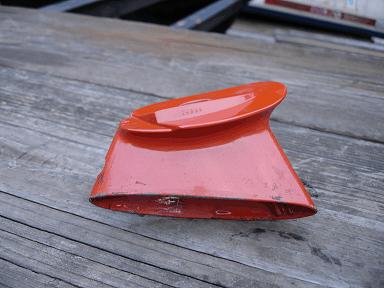
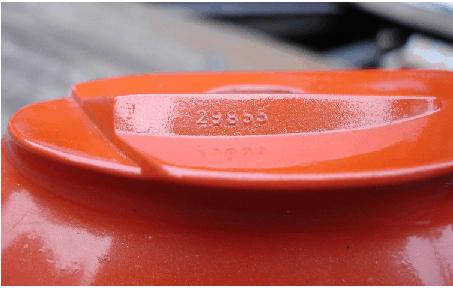 Here are pictures of the left mirror base, including a close-up
of the casting number.
Here are pictures of the left mirror base, including a close-up
of the casting number.
The mirror glass is also date coded on Sport Mirrors. The
code is etched at the top of the glass and lists the number of the month
first, then the manufacturers logo, and finally the last digit of the production
year. The below example of "2-DMI-2" would decode as February
of 1972.
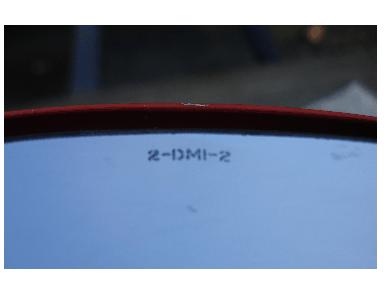
Summary
Listed below is the information needed to identify the correct
mirrors for both 70-72 Buick & 71-72 Oldsmobile A-bodies.
Upper Housing
Casting Number 29853 (Left), 29843 (Right) (Numbers are located behind the
mirror.)
Date Codes Anywhere from the middle of the 70-model year until the end of
the 72-model year. (The date code clock is located next to the casting number.)
Lower Housing
Casting Number 29855 (Left), 29845 (Right) (Numbers are located on the top
of the part, where they attach to the upper housing.)
Date Codes (None)
Mirror Glass Assemblies
Casting Number 29854 (Left), 29844 (Right) (Numbers are located on the black
plastic backing assembly, on the backside of the mirror.)
Date Codes Anywhere from the middle of the 70-model year until the end of
the 72-model year. (Date codes are etched into the glass at the top of the
mirror.)